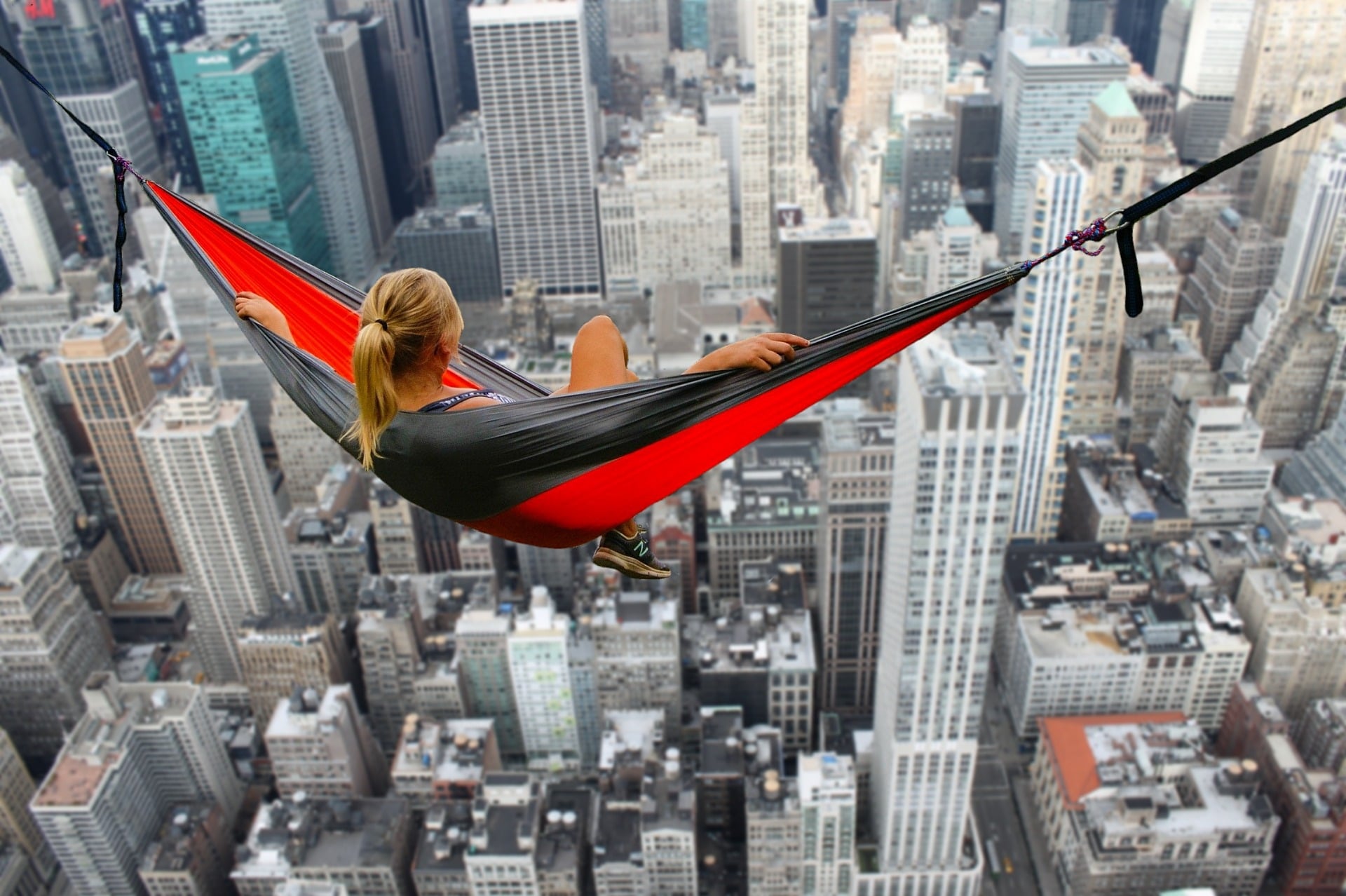DO YOU SUFFER FROM THE FEAR OF HEIGHTS?
Activities at heights (climbing, mountain hiking, via ferrata, canyoning…), or simply being in high places are all activities that seem pleasant when you do not suffer from acrophobia. If you suffer from acrophobia, i.e. the fear of heights, these hobbies are rather signs of suffering for you.

Table of contents
- What is acrophobia?
- Differences between vertigo and acrophobia
- What are the origins of the fear of heights?
- What are the prevalences of this fear of emptiness?
- What are my symptoms when I have a panic attack related to my fear of heights?
- How does this affect your life?
- Tips for resisting in situations
- What treatment?
1. What is acrophobia?
Acrophobia is the excessive and irrational fear of high places. Its name is derived from the Greek prefix “accro” which means “high”. It is a specific situation phobia, which can be disabling in your social, professional and daily life.
This extreme anxiety is considered dysfunctional because it is not related to the reality of the danger of the situation. Thus, panic can manifest itself in a real situation (when you are on top of a mountain), or in an imagined way.
Furthermore, this fear can be vicarious. That is to say that you are afraid when you see or imagine someone being in a situation that may be anxiety-provoking for you. For example, when your son is at the edge of a cliff looking at the landscape.
2. Differences between vertigo and acrophobia
a. Vertigo
Vertigo is a physiological or organic reaction. It is a vestibular disorder, i.e. difficulties related to balance. The vertigo can thus be due to a failure of the internal ear. In fact, the inner ear is an organ that, in addition to being useful for hearing, has the purpose of synchronizing the movement of the head and eyes with the posture of the body.
Although this disorder is not serious, it can make certain aspects of daily life difficult. Thus, we will feel a sense of loss of balance, a feeling of being in danger of becoming unwell or that the world is spinning around you. These sensations can be triggered in any context (e.g. standing in the street, sitting on a chair, lying down, etc.).
A sensation of vertigo can last several days. Nevertheless, to treat vertigo, it is necessary to go see an ENT specialist who will help you in this sense.
b. Acrophobia
Unlike vertigo, acrophobia is not physiological but psychological. Indeed, the fear is real but the discomfort is not of physical origin. However, you will be able to feel physical sensations caused by the anxiety.
In acrophobia, the discomfort will appear in a phobogenic situation (i.e. in a situation that makes you anxious). You therefore suffer from acrophobia when you feel unwell exclusively in a height situation (or when you visualize someone at a height). This is why this situation can be disabling and limit you in certain activities.
The feeling of anxiety is not lasting. Unlike vertigo, which can last several days, the anxiety manifested in acrophobia lasts about twenty minutes in a situation. To treat acrophobia, we will turn to a psychologist.
3. What are the origins of the fear of heights?
There is no single possible cause for acrophobia. Indeed, it can be due to a trauma, to education, to a problem of vertigo or by hereditary factors. Nevertheless, the phobia is a strong and lasting one due to all the avoidance of situations that could harm you. For example, when you are offered a hike, you refuse on the pretext that you already have a weekend at the beach. In the same way, if you have to cross a bridge, you turn back to change the road because that one puts you in too much difficulty.
a. Traumatic origin
Acrophobia can be triggered at any time in life following a trauma. This trauma may have occurred several years ago, may not have had a direct impact, and may come back at some point without your knowledge.
For example, you went for a mountain walk with your family when you were a child and you came very close to falling. This event has become part of you, and a similar situation has triggered the anxiety you may have had at that time.
Finally, you can also experience the trauma vicariously. Indeed, you have heard the story of someone or seen a friend fall from a cliff, and this has created intense anxiety in you in these same situations.
b. Educational background
To begin with, overprotection by your family may be at the root of your acrophobia.
You may come from a family in which your parents, grandparents, brothers, sisters… kept telling you to be careful, warning you about certain situations, forbidding you to do certain activities at altitude for fear of danger.
In addition, your family may have further worried you with stories about other people who had accidents in the mountains or from a balcony for example.
c. Consequence of dizziness
Then, you may have suffered from vertigo and your symptoms were triggered in a height situation. As a result, your brain ended up assimilating the sensations of vertigo to heights and amalgamated the situation.
Thus, when you are in a situation of height, you feel the same nausea or the same sensations that you can have in your moments of vertigo.
d. Hereditary origin
Finally, the onset can be hereditary. Indeed, if one or both of your parents are acrophobic, you are more likely to be too.
But be careful, genetics alone is not enough to have this phobia. On the other hand, it can create predispositions to your anguish in front of these situations.
4. What are the prevalences of this fear of emptiness?
In the general population, acrophobia affects 2 to 5% of people. Twice as many women as men suffer from it. It also affects mostly people over 50 years old.
a. The only phobia that increases with age
Generally speaking, our childhood fears diminish as we grow up. The phobias that resurface come, most often, in an age range between 15 and 30 years. Thus, it tends to appear during adolescence. On the other hand, it can appear much later. The phobia of heights would be the only phobia that can appear in old age. This can be explained by different factors.
b. The balance
As we age, our sense of balance diminishes and we perceive heights in a completely different way. Indeed, the inner ear functions less well and impacts the vestibular system. We then feel more dizzy sensations related to situations at height.
c. Sense of vulnerability
Second, as we age, we have a greater sense of vulnerability. Indeed, we are more aware of the consequences of our actions and we are afraid of certain reactions of our body. It is true that with age, we lose stability, and we fear losing that balance in a high situation.
5. What are my symptoms when I have a panic attack related to my fear of heights?
When you are high (or see someone high), feelings of anxiety arise. Your heart rate may increase, creating a tachycardia that makes you feel uncomfortable. You may experience excessive sweating, and chills or hot flashes.
In addition, you may feel a sense of attraction to the void. This attraction is particularly frightening to you, and you do not understand it. In addition, you may feel a sense of loss of balance, or dizziness and lightheadedness.
If your anxiety becomes particularly strong, you may also feel as if you are running out of air and cannot breathe easily, have physical pains in your body, nausea, a feeling of depersonalization (going out of your body, going crazy, loss of self-control), a feeling that the whole situation is unreal, an extreme fear of dying etc.
6. How does this affect your life?
When we are afraid of emptiness, we often create avoidance in front of these situations. We limit ourselves in our physical, cultural and social activities. This phobia will prevent you from taking part in certain activities with your group of friends or family. When they want to go hiking, visit certain monuments, do altitude sports, go for a drink on a rooftop… You will not be able to do some work either (climbing on a roof, being on a stepladder to change a light bulb etc).
The people around you will want to continue these activities, and you may feel excluded. This isolation from your group of friends may make you feel depressed.
7. Tips for resisting in situations
Having alternative strategies can help you get through a situation when you are high, but does not solve your difficulties. It is therefore important to be able to use them in an “emergency” situation, but they do not replace a therapeutic follow-up. Therapeutic follow-up allows you to stop dealing with these situations in a sustainable way.
a. Breathe
Learn to breathe consciously. Inhale through your nose and expand your belly. Let the air enter your body, and enjoy the freshness of the air entering you. Take your time. Breathe out, through your mouth, deflating your belly.
b. Hydrate
Dehydration creates a strong fatigue and thus decreases the cognitive functions. It affects brain activity. Tasks become increasingly difficult to perform when dehydrated.
c. Find nearby landmarks
You can narrow your field of view by restricting the space around you. Focus on a tree near you, a rock a little further away… If you can’t find a landmark too close, imagine it. Visualize a point (white, black, green) in your direction, and focus on it.
8. What treatment?
Like all phobias or anxieties, the earlier it is considered and treated, the easier it will be to make the symptoms disappear. On the other hand, it is never too late to take charge of your life.
Therapeutic follow-up is essential. Cognitive-behavioral therapies (CBT) have been proven to be effective in the treatment of vacuum phobia. Virtual Reality Exposure Therapies (which are part of a CBT dynamic) will allow the patient to confront these anxiety-provoking situations in order to create a habituation of the latter. The exposure to these phobogenic situations will be done in a gradual way, to apprehend the techniques and the tools to palliate them, from relaxation to listening and accepting one’s emotions. Little by little, anxiety about these situations will diminish.

